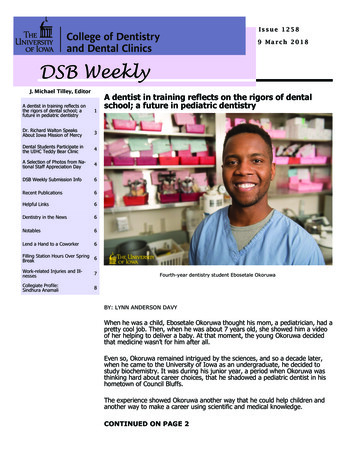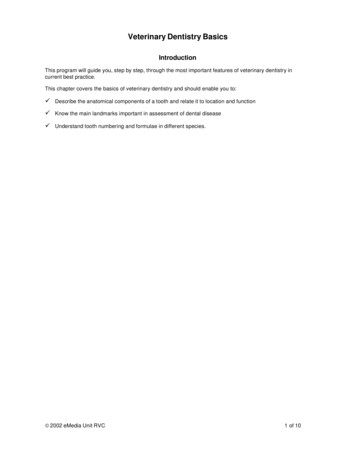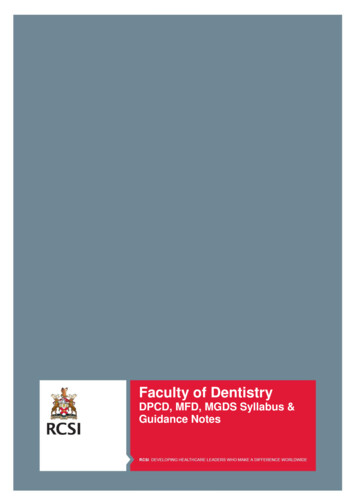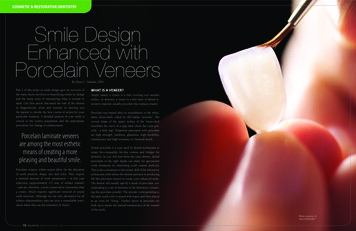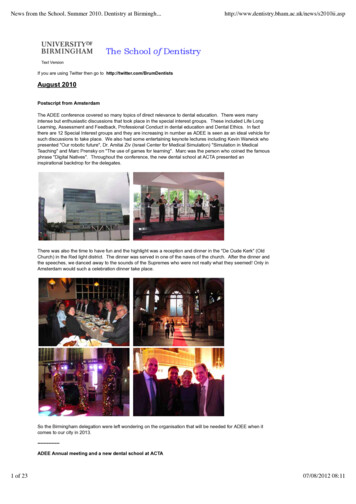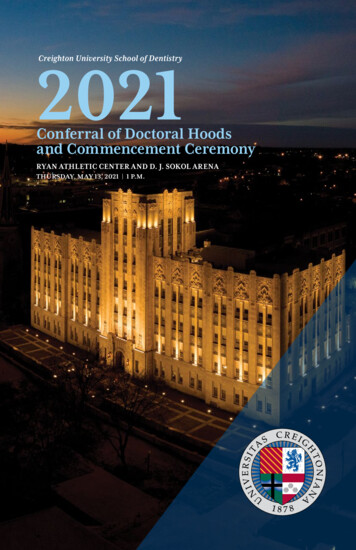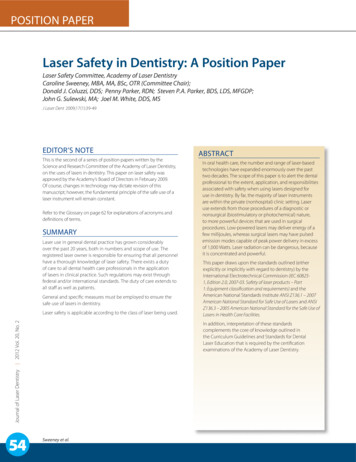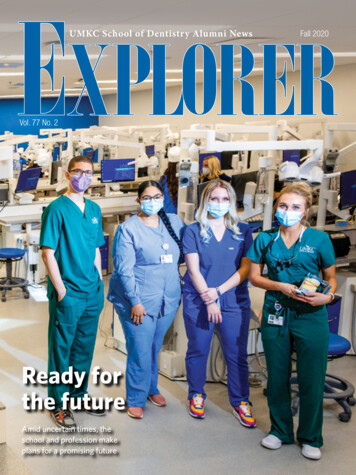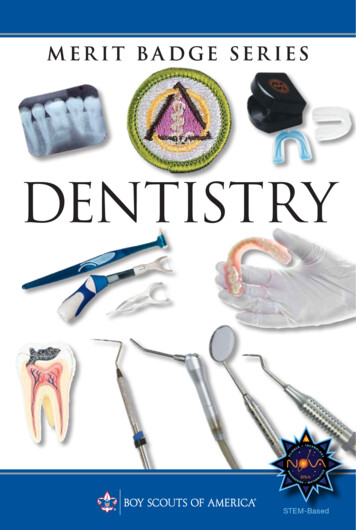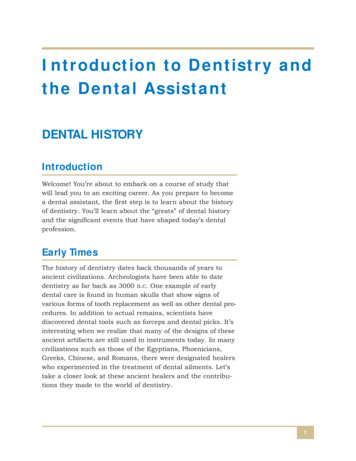
Transcription
Introduction to Dentistry andthe Dental AssistantDENTAL HISTORYIntroductionWelcome! You’re about to embark on a course of study thatwill lead you to an exciting career. As you prepare to becomea dental assistant, the first step is to learn about the historyof dentistry. You’ll learn about the “greats” of dental historyand the significant events that have shaped today’s dentalprofession.Early TimesThe history of dentistry dates back thousands of years toancient civilizations. Archeologists have been able to datedentistry as far back as 3000 B.C. One example of earlydental care is found in human skulls that show signs ofvarious forms of tooth replacement as well as other dental procedures. In addition to actual remains, scientists havediscovered dental tools such as forceps and dental picks. It’sinteresting when we realize that many of the designs of theseancient artifacts are still used in instruments today. In manycivilizations such as those of the Egyptians, Phoenicians,Greeks, Chinese, and Romans, there were designated healerswho experimented in the treatment of dental ailments. Let’stake a closer look at these ancient healers and the contributions they made to the world of dentistry.1
The EgyptiansOne of the greatest civilizations of ancient times was that ofancient Egypt. The ancient Egyptians excelled in many areasof science, one of these being dentistry (Figure 1). Historianshave been able to determine that one of the earliest dentistsin ancient Egypt was Hesi-Re, who lived about 2700 B.C. It’sfelt that he was one of the greatest scientists of his time to besolely concerned with the treatment of dental pain.Figure 1—As evidenced bythis papyrus scroll filledwith dental markings, theEgyptians were amongthe first civilizations topractice dentistry.(Courtesy of the SmithsonianInstitution, NMAH/ MedicalSciences)It’s believed that the Egyptians experienced all of the majordental diseases, including caries (cavities) and periodontal(gum) disease. However, they also suffered from ratherunique types of dental problems due to their culture. Thebasic diet of the Egyptians consisted mainly of breads andplants. The bread was made of grains that were ground onrough stones. This method caused small pieces of stones tobecome incorporated into the bread dough. Unfortunately,they had no means of extracting these stones and they werebaked into the bread. This produced a very coarse bread. Inaddition, since the area in which the Egyptians lived was verysandy, the plants they ate were often gritty. The combination2Introduction to Dentistry and the Dental Assistant
of these two factors caused extensive wear and attrition(grinding down) of their teeth, leading to problems such asnerve exposure and abscesses (tooth infections).The dental work available to the ancient Egyptians mainlyconsisted of extractions and management of dentalabscesses. They didn’t put a high priority on either oralhygiene or preventive care. Archeologists have never locatedany type of a toothbrush or dental cleaning device at anEgyptian site. Their main concern appears to have been thetreatment of ailments after the onset of disease.It’s also interesting to discover that the Egyptians seemed toplace more emphasis on dental care after death. Historianshave learned that the replacement of teeth by artificial meansseemed to occur only after death. The Egyptians mummifiedtheir corpses. However, before this was done, the body wasmade to be as intact as possible, including the replacementof missing teeth. They believed that this ritual helped to prepare the person for the afterlife.The PhoeniciansThe Phoenicians were an ancient civilization who occupiedthe area known today as Syria and Lebanon. Theirs was aculture that consisted mainly of traders. These ancient seamen traveled the Mediterranean Basin, gaining knowledge oftechnologies such as dentistry.The beginnings of several dental technologies can be found inthe Phoenician civilization. Much of their dental knowledgewas influenced by their contemporaries, the Egyptians. Onesuch example is in a treatment of periodontal disease. TheEgyptians used a technique for treating teeth affected byperiodontal disease where the mobile teeth were splinted(fixed together). The Phoenicians took this technique andrefined it. Skulls have been found in archeological digs thatdemonstrate periodontally compromised teeth, which havebeen splinted with gold wire. This technique used by thePhoenicians isn’t unlike the techniques preferred by somedentists today.Introduction to Dentistry and the Dental Assistant3
The Phoenicians also experimented in bridgework. Severalexamples of fixed bridgework have been found in skullsunearthed during archeological digs. Carved-ivory false teethwere attached to natural teeth by thin gold wire (Figure 2).The Phoenicians’ dental knowledge was passed on to otherancient civilizations, thus making them a major factor in theadvancement of dental awareness and technology.FIGURE 2—A PhoenicianExperiment inBridgeworkThe GreeksThe ancient Greeks lived and flourished in an age of discovery. It was during the time of this civilization that manyadvancements were made in the field of medicine. The earliest of these advancements occurred in the fifth century B.C. Amedical school located on the Isle of Cos and Cnidus was thecenterpiece of discovery at that time.The Greeks worshipped a variety of gods. Much of the medicine that was practiced at this time was based on theworship of Asclepius, the Greek god of healing and medicine.The manner in which a toothache was treated was also basedon this worship. A patient with a toothache was brought to apriest for medical treatment. The first phase of the treatmentwas a form of relaxation. The patient was given a sleepinducing potion that helped to bring him or her into a stateof relaxation. The priest would visit the patient while he orshe was in this semiwakeful sleep. He would instruct thepatient on a course of treatment. If the treatment was successful, the patient would have to make some type of tributeto the healing temple. The tribute generally took the form of4Introduction to Dentistry and the Dental Assistant
stone tablets carved in the shape of the afflicted body part, inthis case a tooth. The tablets would have writing carved intothem with words praising Asclepius. Numerous stones carvedin the shape of teeth have been found at archeological digs atancient temples.Hippocrates, widely considered the father of modern medicine, performed research and wrote books about maladies ofthe teeth and mouth. He believed that all dental problemswere related to a natural inherited weakness of the body. Hewas against the use of extractions as a treatment unless atooth was loose and, therefore, unable to be saved. Carious(decayed) teeth, he thought, should be treated symptomatically and not removed.Another famous Greek physician named Claudius Galen,living between A.D. 120 and A.D. 199, is best known for hiswritings on medical advances during his era. Part of his medical writing included information on dentistry and dentalanatomy. Galen documented in his writings that teeth aremade of bone. It was his belief that, since teeth are exposed,they must contain nerves within their structure. Today, weknow this theory is correct.The ChineseAncient China introduced many innovations to the field ofdentistry. The Chinese developed several methods of treatingtooth disease, many years before they were used in westernEuropean countries. For example, they began treatingtoothaches with arsenic about A.D. 1000. They’re also notedfor using silver amalgam (a metal mixture) for filling teeth.The Chinese were also very advanced in their observation ofthe oral cavity. Dentistry is discussed in an ancient workcalled the Canon of Medicine (compiled between 476-221 B.C.),which has a section dedicated specifically to mastication(chewing) and deglutition (swallowing). The Chinese were alsointerested in systemic diseases and their connection to oralmanifestations. For example, they recognized that prior to thedevelopment of measles, white spots would appear in a person’s oral cavity.Introduction to Dentistry and the Dental Assistant5
Scientists have discovered many ancient Chinese writingsregarding abscesses, tooth extraction, and the instrumentsused in dentistry. The Chinese based many treatments forabscesses on scientific observation. Finally, Chinese surgeonsdelved extensively into surgical treatments of the oral cavity.For example, there’s written documentation regarding tumorremoval and surgical repair of damage due to trauma (injury).They also dealt extensively with early repair of cleft palates(abnormal openings in the roof of the mouth) and othercongenital (birth) defects.The RomansThe writings of ancient Roman scientists and scholars are anexcellent source for information relating to the lifestyles ofancient times (Figure 3). Not only did they write about theirown discoveries and culture, they wrote about those of otherancient civilizations.Aulus Cornelius Celsus was a Roman scholar who lived during about A.D. 30. He wrote a book called On Medicine, whichis considered to be one of the best medical works of its time.FIGURE 3—AnExample of a RomanDental Instrument6Introduction to Dentistry and the Dental Assistant
Celsus wrote on several areas of dentistry. One subject ofinterest to him was in the induction of sleep for patients whosuffered from toothaches. He wrote quite a bit on the treatment of pain from dental abscesses. The writings of Celsusalso documented the first recognized cases of orthodontictreatment, accomplished through the use of appliances andfinger pressure.The Middle AgesThere were a few notable discoveries during the Middle Ages.One of the most prominent was by a physician namedScrapion, who lived during the tenth century. This physician,through his research, accurately described the number ofroots found on particular teeth. He hypothesized correctlywhy teeth contain a different number of roots: he believedthat lower molars only required two roots due to their strongjaw support. He also noted that, in contrast, upper molarsrequired three roots as they have less jaw support.Another notable figure in dentistry during the Middle Ageswas Abulcasis, who lived in Spain between 936 and 1013. Hewrote many works on the necessity of oral hygiene. Theseworks emphasized the importance of cleaning teeth and theconsequences of not doing so. Abulcasis also wrote a list ofrules for completing dental extractions, including his opinionthat any tooth extraction should be done only as a lastresort. He describes methods of transplanting teeth andusing gold wires to support loose teeth.There’s little documentation of any advances in the dentalfield during the rest of the Middle Ages. It wasn’t until thedawn of the Renaissance that medical science flourished. Itwas during this time that the study of dentistry became aseparate science among the prestigious scientists of the day.The RenaissanceThe Renaissance was a time of rediscovery and technologicaladvancement. Methods of printing information advanced asmovable type became available, thus making it easier thanever before to record and spread knowledge. Scholars werenow able to share their discoveries through the printed word.Introduction to Dentistry and the Dental Assistant7
Many great scientists of medicine emerged during this period.One of the most noted was Andreas Vesalius (1514–1564).His works were so far advanced for his time that he’s considered the father of modern anatomy. His main contribution tothe field of dentistry is in mastication. He discovered thatteeth all have a different pattern of bite, called occlusion.A French contemporary of Vesalius was Ambroise Paré, who’sconsidered to be the father of modern surgery. In addition tohis other accomplishments, Paré made many advancementsin the study of dentistry, especially with regard to reconstruction. He produced artificial teeth to replace those lostdue to trauma and periodontal disease. He’s also known forhis creation of the first fabricated obturator, a device used toclose the opening left by a cleft palate. A cleft palate is a congenital abnormality that can extend into the patient’s nasalsinus, causing difficulties in eating and swallowing. Paréwrote extensively on tooth extractions and methods of toothreimplantation after a tooth has been evulsed (torn away) byacute trauma.It was between 1650 and 1800 that thescience of modern dentistry becameestablished. Among the leaders of thisadvancement, during the early tomid-1700s, was Pierre Fauchard (Figure 4).His discoveries earned him the title ofthe “Father of Modern Dentistry.” Eventoday, his writings are considered to besome of the most important publicationsin dentistry.Fauchard’s writings were quite involvedfor his time, including detailed descriptionsof treatment techniques and drawingsand descriptions of instruments. It washis opinion that dentists should berecognized as specialists separate frommedical doctors, and should hold the titlesurgeon dentists. This title is still used inFrance today.FIGURE 4—Pierre Fauchard8Introduction to Dentistry and the Dental Assistant
Fauchard’s interests included all facets of dentistry. In fact,he was the first to contradict Galen’s theory of “toothworm”(the idea that cavities are caused by toothworms). He believedthat cavities were formed by physical actions rather than thepresence of toothworm. He emphasized the importance ofdental hygiene. He also wrote about his experiments withfilling cavities with tin or lead.Fauchard fabricated several types of tooth replacement devices.He made bridges using gold wire and ivory teeth for limitedtooth replacement. He created designs for full dentures usinggold, ivory teeth, and springs for retention. He also experimented with the replacement of traumatically evulsed teeth.A scientist named John Hunter took the beginnings of thepractice of too
ical writing included information on dentistry and dental anatomy. Galen documented in his writings that teeth are made of bone. It was his belief that, since teeth are exposed, they must contain nerves within their structure. Today, we know this theory is correct. The Chinese Ancient China introduced many innovations to the field of dentistry. The Chinese developed several methods of treating .
